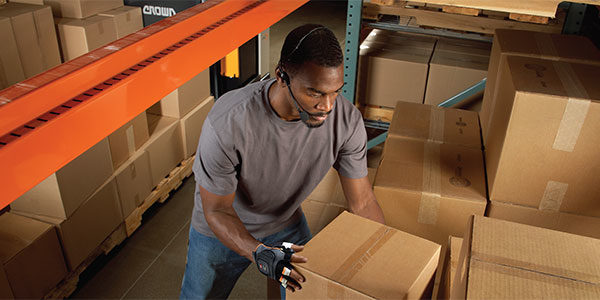Warehouses make room for wearable computers

Stop by your local Best Buy or Staples, and you'll see that wearable computers are among the most popular consumer electronics on retail shelves, from the Fitbit and Apple Watch to a host of other devices that track our heartbeats, footsteps, and more.
Wearable technology is good for more than just checking texts and shedding pounds, however. The portable devices can also help warehouse workers boost their efficiency by 10 to 20 percent.
When DC employees don a voice-command headset, finger-trigger glove, belt-mounted scanner, or Google Glass goggles, they gain a two-way communication channel with crucial software platforms such as the warehouse management system (WMS) or labor management system (LMS).
With both hands freed up for picking and a direct line feeding them instructions for the next task, workers with wearable computers can get their work done faster and more accurately than their colleagues who have to walk back to the lift truck or the end of the aisle for new instructions after every pick.
E-COMMERCE DRIVES DEMAND FOR WEARABLESAnother factor driving the adoption of wearable computers is the struggle to meet the demands of fulfilling online orders placed by individual consumers.
"Warehouses are seeing a change in material handling demands as they deal with smaller, more frequent picks because of e-commerce and direct-to-consumer orders," says Mark Wheeler, director of supply chain solutions at Zebra Technologies. "With this changing order profile, the case for hands-free computing remains solid."
Ironically, logistics managers tend to look at wearable computing devices only after they've tweaked everything else in the DC, such as the layout or the fulfillment process, Wheeler says. When they finally look at ergonomics, they quickly discover that arm-mounted or voice-directed devices that free up workers' hands can go a long way toward helping them pick faster.
The use of wearable computers can also pay off in preventing mispicks and mistakes—a crucial attribute in an e-commerce environment, where online retailers are rushing to deliver individual items to buyers' homes overnight.
"The value of wearable tech is as much about accuracy as productivity. In e-commerce, it has to be 100 percent right; there's a premium put on order accuracy," Wheeler says. "So you have to be sure that technology is not getting in the way of (accuracy) because a user is distracted by handling the device."
JUST ONE PART OF THE PICTUREThat's not to say that managers can automatically boost productivity simply by dropping wearables into a DC operation. As with any technology, wearable tech has to be judiciously incorporated into the process, experts warn.
"There are process changes the customer has to accept to make the improvements come to life," says Jim Gaskell, director of global technology business development at Crown Equipment Corp. "Everybody on the consumer side buys wearables because they're cool. But it takes a little more than that to use them effectively in the warehouse."
For example, a warehouse manager may distribute voice headsets to workers on the floor, but the system won't boost a team's picking speed if the WMS is running on a slow or buggy computer.
"I've seen people hit the button after making a pick and then stand around waiting for the next command. You have to make sure there's no latency in how the WMS spits out the next order. Otherwise, there goes your improvement," Gaskell says.
Even if everything is working properly, DCs may find they have to make tweaks to their operations to get the most from their investment in wearables. For example, in order to capitalize on the speed made possible by wearable devices, some facilities may have to re-slot fast-moving goods with an eye toward cutting down on order pickers' travel distances.
Similarly, facilities that handle case-picking may find they have to re-slot inventory items to facilitate the building of optimal pallet loads. Just as baggers at a grocery store place the heaviest items on the bottom so a water jug doesn't smash a loaf of bread, warehouse pickers have to stack cases on pallets so that the lightest goods are on top. To get the biggest return on its investment in high-speed wearable computing devices, a DC may have to rearrange its goods in a pattern that allows workers to follow this principle.
In addition to that, DCs may find that once they begin using wearables for order picking, they have to update the time standards in their labor management systems. Wearable devices usually enable users to get tasks done faster, but unless the LMS is updated to reflect higher performance targets, employees may simply use the technology to reach their quota faster and then slack off.
And finally, though it may sound obvious, implementing wearable computers works best when customers think about why they're buying the tools before choosing a new "toy." Finger-trigger controls for semi-autonomous lift trucks are neat gadgets, but sometimes a simple headset is a better fit for the job.
NEW AND IMPROVEDJust as happens in the world of consumer electronics, users of wearable computers in the workplace are never quite satisfied. As soon as they become accustomed to using the devices, they start looking for upgrades. As for what they want, vendors say the requests include calls for lighter, more comfortable designs as well as longer-lasting batteries.
However, many of these upgrades are harder to make in devices used in the warehouse than for consumer electronics, Zebra's Wheeler says. For instance, when wearables are used constantly throughout the day and through successive work shifts, their batteries run down much faster than a basic smartphone's would. The drag on the battery is even greater when users operate the mobile device in a cooler or freezer, or when they use a voice-directed function.
And the user demands don't stop there. Vendors of wearable computers also report that they're fielding requests for enhanced wireless performance that can keep up with order pickers who are constantly on the move, as well as keys designed to allow users to operate the devices without stopping to look at them.
And it almost goes without saying, users want all this in a device that's rugged enough to survive a tough double shift. "If a computer is wearable on the hip or arm, it probably won't be dropped," Wheeler says, "but on the warehouse floor, it is certainly in harm's way. It will get smacked around quite a bit, so it should still be able to break away for safety."
Related Articles

Copyright ©2024. All Rights ReservedDesign, CMS, Hosting & Web Development :: ePublishing